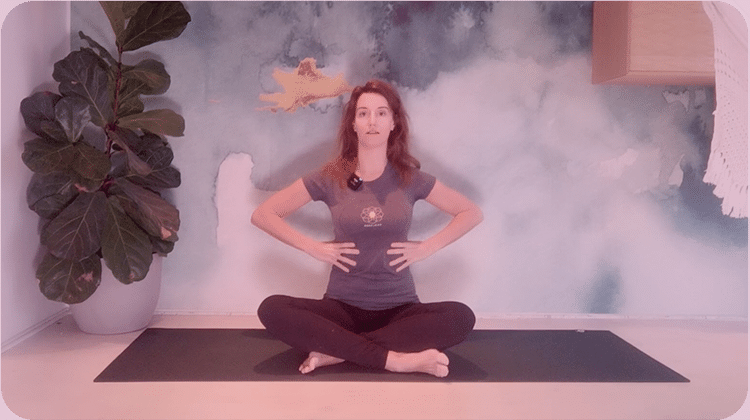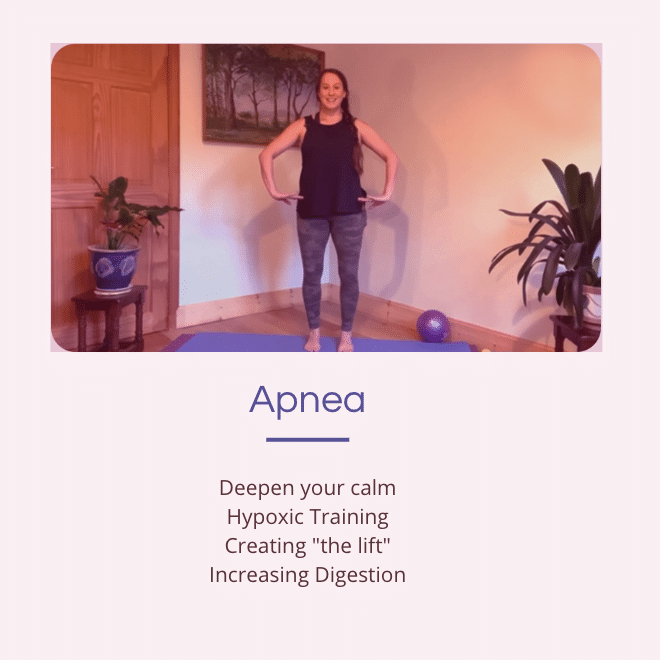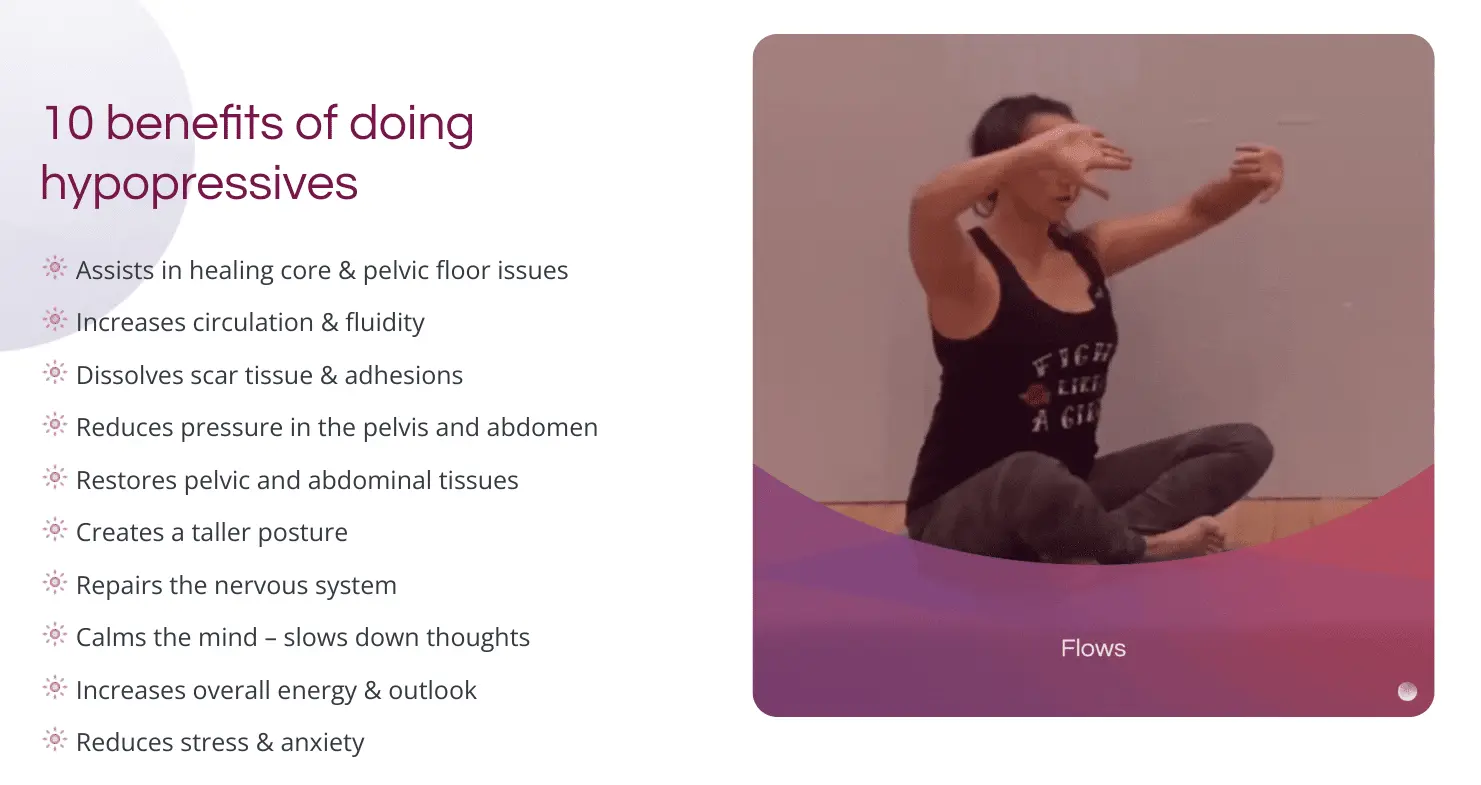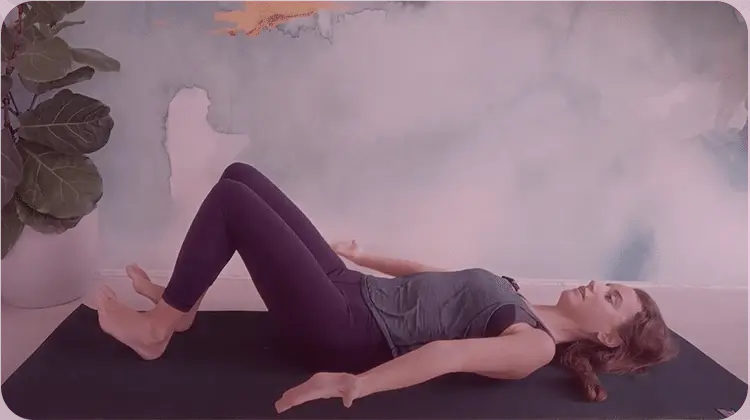Hypopressive breathing exercises: What you need to know
- January 18, 2023
- Pelvic Floor

How can breathing exercises help improve symptoms of pelvic dysfunction? It’s a question I get all the time.
And it’s a great question because there is no obvious answer.
The thing is, most women are told to do Kegels when pelvic symptoms are present.
Rarely is one told about Hypopressive breathing exercises because most doctors and physiotherapists are not trained in this technique.
This is why I’m writing about this topic today. The goal is to bring awareness to this incredible method, called Hypopressives.
This method was a huge reason I reversed a Grade 3 prolapse a few years ago.
Ready to learn why Hypopressive breathing can be an amazing tool in your pelvic healing toolkit?
Let’s get started!
What are Hypopressives?
First, we must begin by answering the most fundamental question – what are hypopressives?
Put simply, Hypopressives are a series of low-pressure exercises designed to address any imbalances in the pelvic floor.

Although created for postpartum women, they are being used by women of all ages, regardless if they’ve had a baby or not.
Also, men practice these exercises to improve their athletic performance, boost lung capacity, and for abdominal training.
Some even say hypopressive breathing exercises give them amazing results compared to traditional core and ab exercises.
Let’s transition back to women for a moment and talk about who specifically seeks out these exercises.
Even though Hypopressives are incredible for prevention, most women with pelvic floor symptoms start using them.
Common conditions & symptoms that Hypopressives address
Women find hypopressive breathing exercises effective for pelvic dysfunctions and other health challenges, including:
- All types of prolapse
- All types of incontinence (urinary & fecal)
- Heaviness in the pelvis
- Dragging and chafing
- Pelvic pain, tightness, or tension
- Excess pressure in the pelvic or abdomen
- Lower back pain
- Hemorrhoids
- Low libido
- Painful sex
- Constipation
- Stress & anxiety
- Trouble sleeping through the night
The fundamentals of Hypopressives
Besides breathing exercises, which we’ll cover in a bit, Hypopressives have another major component to them.
The other fundamental part of this low-pressure fitness technique is posture and alignment. Believe it or not, your posture impacts your pelvic floor health and the way you breathe.
Also, poor posture can create more pressure and tension in the pelvic floor. It can also cause adhesions in the fascia system. The combination of excess pressure, tension, and damaged fascia is what creates pelvic dysfunction in the first place.
So, you can see why correct posture is such an important piece in the healing puzzle.
Now let’s get into why Hypopressive breathing is hugely important for healing as well.
Hypopressives breathing exercises for better pelvic floor health

Breath is life. You may have heard this popular saying before. There’s no denying that breath is vitally important. But, did you know that the majority of the breaths you take throughout your lifetime happen unconsciously?
That means it happens without you thinking about it. It also means we spend very little time paying attention to how we breathe.
When you stop to observe and listen, you may discover that you breathe in a shallow/quick way, or heavily, or mainly from your upper chest, or maybe from your belly.
You’ll get to tune into your breath in Hypopressives and learn about diaphragmatic breathing. You’ll discover how this is different from belly breathing and why it’s ideal for reversing pelvic dysfunction.
Also, there are two types of breathing that you’ll discover when practicing Hypopressives. They include lateral and apnea breath and both involve breathing diaphragmatically.
How about I take a moment to talk about lateral breathing and the apnea breath?
Lateral breathing

When you breathe laterally it means you are breathing in all directions – from the front, sides, and back of your rib cage.
This type of breathing activates your diaphragmatic muscles, which is how you accelerate the healing of your pelvic floor.
More specifically, breathing this way activates the nerve endings and fascia in your pelvic floor. This activation helps reduce pressure and dissolve scar tissue in your pelvic floor – aiding the healing process.
Curious to see how lateral breathing feels? If so, give it a try and follow along with me in this video.
Apnea breath
One way to think about the apnea breath is by associating it with “breath holds”. During this breathing technique, you perform a false inhalation.
This is done by breathing in, breathing out, then opening up your rib cage as if you are inhaling again. But the difference is you’re not breathing in any air this time.

What’s the benefit of this false inhalation?
When you open up your rib cage without allowing air to come in – you activate the muscles, fascia, and nerve endings in your diaphragm. This not only benefits the health of your chest diaphragm, but your pelvic diaphragm too since these share a unique connection.
In addition, the false inhalation creates a “lift effect” that helps guide your pelvic organs back up to their proper position. This is especially important and valuable for women with a prolapse.
However, there is a high risk of practicing the apnea breath incorrectly given its complexity. Therefore, it’s not advised to do the apnea breath without being observed and critiqued.
This is why our Hypopressives course includes this key element. We ask each of our customers to send us videos of them practicing the posture, lateral breath, and apnea breath exercises.
From there, I can observe their technique and send them a personal video with my feedback. This is done before they receive the more advanced set of Hypopressives exercises. Because the ultimate goal is safety and symptom improvement.
How can you learn more about Hypopressive breathing exercises?

I’m so glad you asked this question! My colleague Abby Lord, Hypopressives Master Trainer, hosts weekly Live Webinars that teach you how to get your core and pelvic health back with Hypopressive Exercises.
These webinars are free to join. For more information about them and to sign up, register here!
Blog posts you might like:






